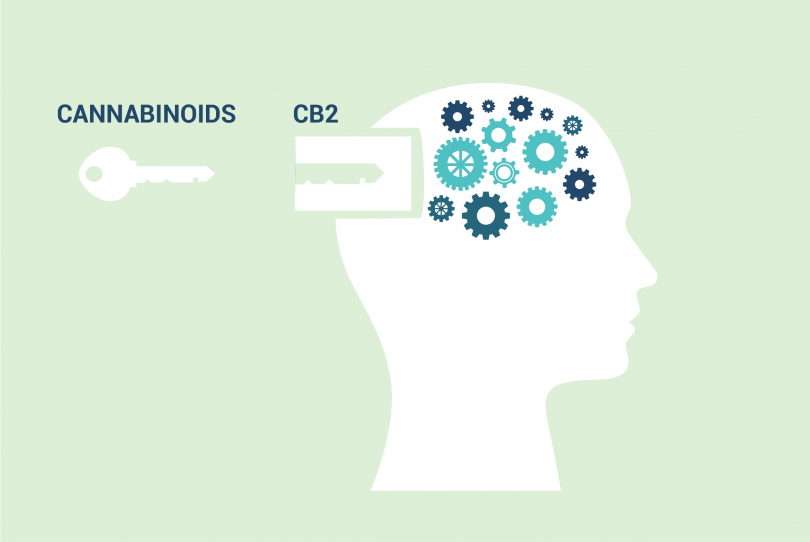Understanding how it mediates the immunomodulatory effects of cannabinoids
Tetrahydrocannabinol (THC) and cannabidiol (CBD) are often perceived as the ying and the yang of cannabis–with the former inducing intoxication and the latter lulling you into sweet calm. This is an oversimplification at best, as these are just two of many different cannabinoids.
When taken in whole plant form, THC, CBD, and various other compounds, like terpenes, create a range of effects that are determined by the genetic disposition of the cultivar. The ratio of these different phytochemicals thus drives the overall experience.
However, a quick search of the web will reveal several graphics showing a dichotomous classification of THC vs. CBD, including their effects and the receptors (or proteins) with which they bind. While the cannabis science community understands that these isolate compounds do not make up the whole of the cannabinoid family, these types of figures help guide an understanding of how the body and brain receive these chemicals and the cascade that unfolds following receptor binding.
Within the past few years, there’s been increased interest in CBD and the “minor” cannabinoids; however, the legacy of THC as the “it” compound in cannabis has drawn much attention to its physiological effects. In fact, the receptor responsible for mediating THC’s effects is called cannabinoid receptor 1 (CB1), as it was identified first; cannabinoid receptor 2 (CB2) was discovered just a few years later. [1]
The CB2 receptor binds endocannabinoids as well as phytocannabinoids, and plays an important modulatory role in the endocannabinoid system. While CB1 is more highly expressed in the brain and spinal cord, CB2 is located in the periphery, including the tonsils, spleen, thymus, pancreas, and other immune-oriented organs. [1]
In 2009, researchers discovered two different isoforms–or similar proteins with slightly different genes–of CB2, one being expressed in immune tissues and the other in the brain’s reward centers and in reproductive organs. These findings suggest two potentially divergent roles for these similar but differing types of CB2 receptors. [1]
At the cellular level, CB2 is expressed on multiple types of immune cells throughout the body, including B and T cells, platelets, mast cells, and monocytes, which collectively form the body’s chemical army to battle foreign substances. These cells release chemicals like interferons and interleukins when triggered by a disruption to the health of your body–that’s why if you stub your toe or cut your finger, you will experience a bit of pain and swelling. These symptoms are your inflammatory factors to promote healing. [1]
Anandamide, which binds to the CB2 receptor on immune cells, can reduce levels of inflammatory factors, thereby causing anti-inflammatory effects. However, 2-arachidonoylglycerol (or 2-AG) seems to be doing the opposite by increasing levels of inflammation or inducing pro-inflammatory effects. While these findings suggest two possible mechanisms of endocannabinoids on CB2-mediated inflammation, these studies were performed in vitro, or in a petri dish; thus, systemic administration could provide greater insights into this area. [1]
Pre-clinical studies have demonstrated that a lack of CB2 receptors can result in widespread inflammation that can lead to organ damage. Administration of compounds that increase CB2 receptor activity in the normal state improve inflammation-related cellular injury across a wide range of conditions, such as traumatic brain injury, hepatitis, and sepsis. [1]
These findings implore us all to take a closer look at CB2 and the agents that affect its function. Many people use cannabinoids to treat various inflammatory conditions, such as rheumatoid arthritis. The pre-clinical evidence, however, also points to potential use in atherosclerosis and inflammatory bowel disease. [1] While whole plant cannabis can provide a swirling array of benefits for the body and brain, isolated compounds that specifically activate CB2 may be more helpful for people with certain autoimmune or inflammatory conditions.
Even if you’re healthy, ingesting compounds that bind to CB2 receptors and enhance their functionality can keep you at the ready to fight against invaders. And, right now, we could all use a super-boost to keep our minds and bodies strong.
[Image Source]Reference
- Turcotte, C, et al., “The CB2 Receptor and Its Role as a Regulator of Inflammation.” Cell Mol Life Sci, vol.73, no.23, 2016, pp.4449-4470. (impact factor: 7.014; cited by: 91)








